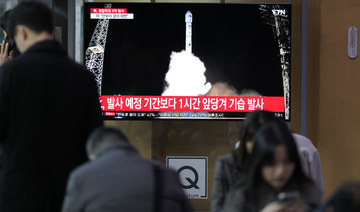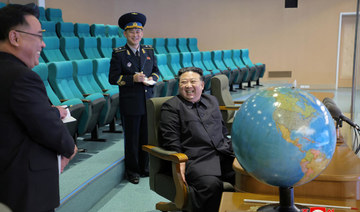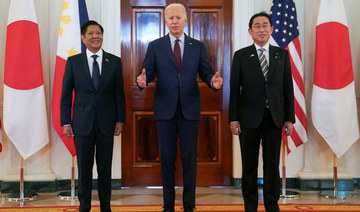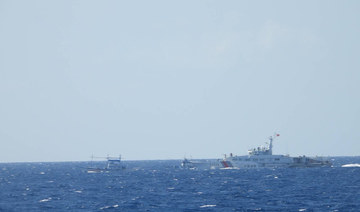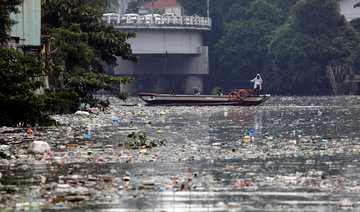WASHINGTON: US President Donald Trump will follow through on a campaign pledge to pull the US out of a global pact to fight climate change, a source briefed on the decision told Reuters, a move that should rally his support base at home while deepening a rift with US allies.
Trump, who has previously called global warming a hoax, did not confirm the decision in a post on Twitter, saying only, “I will be announcing my decision on the Paris Accord over the next few days.”
Trump had refused to endorse the landmark climate change accord at a summit of the G7 group of wealthy nations on Saturday, saying he needed more time to decide. He then tweeted that he would make an announcement this week.
The decision will put the US in league with Syria and Nicaragua as the world’s only non-participants in the Paris Climate Agreement. It could have sweeping implications for the deal, which relies heavily on the commitment of big polluter nations to reduce emissions of gases scientists blame for sea level rise, droughts and more frequent violent storms.
The accord, agreed on by nearly 200 countries in Paris in 2015, aims to limit planetary warming in part by slashing carbon dioxide and other emissions from the burning of fossil fuels. Under the pact, the US committed to reducing its emissions by 26 to 28 percent from 2005 levels by 2025.
Axios news outlet, which first reported the withdrawal, said details of the pullout are being worked out by a team that includes EPA Administrator Scott Pruitt. The choice is between a formal withdrawal that could take three years or leaving the UN treaty that the accord is based on, which would be quicker but more extreme, according to the Axios report.
The decision to withdraw from the climate accord was influenced by a letter from 22 Republican US senators, including Majority Leader Mitch McConnell, calling for an exit, Axios reported.
Former President Barack Obama, who helped broker the accord, praised the deal during a trip to Europe this month.
The US is the world’s second-biggest carbon dioxide emitter behind China.
Supporters of the climate pact are concerned that a US exit could lead other nations to weaken their commitments or also withdraw, softening an accord that scientists have said is critical to avoiding the worst impacts of climate change.
Canada, the EU, and China have said they will honor their commitments to the pact even if the US withdraws. A source told Reuters that India had also indicated it would stick by the deal.
Promise kept
Trump had vowed during his campaign to “cancel” the Paris deal within 100 days of becoming president, as part of an effort to bolster US oil and coal industries. That promise helped rally supporters sharing his skepticism of global efforts to police US carbon emissions.
After taking office, however, Trump faced pressure to stay in the deal from investors, international powers and business leaders, including some in the coal industry. He also had to navigate a split among his advisers on the issue.
Trump aides including Steve Bannon, Stephen Miller, lawyer Don McGahn and Peter Navarro, along with EPA chief Pruitt, argued hard for leaving the accord. They said the deal would require the US government to regulate greenhouse gas emissions, which would hurt business.
Trump’s administration has already begun the process of killing Obama-era climate regulations.
The “stay-in” camp, which included Trump’s daughter Ivanka, chief economic adviser Gary Cohn, and Energy Secretary Rick Perry, had argued the US could reduce its voluntary emission-cuts targets while still keeping a voice within the accord.
Oil majors Shell and Exxon Mobil have also supported the Paris pact, along with a number of Republican lawmakers. Several big coal companies, including Cloud Peak Energy, had publicly urged Trump to stay in the deal as a way to help protect the industry’s mining interests overseas, though others asked Trump to exit the accord to help ease regulatory pressures on domestic miners.
Trump has repeatedly expressed doubts about climate change, at times calling it a hoax to weaken US industry. An overwhelming majority of scientists, however, say climate change is driven by human use of fossil fuels.
Donald Trump pulling US out of Paris climate deal
Donald Trump pulling US out of Paris climate deal

Parts of Bangladesh and India affected as storm floods villages, cuts power to millions

- About 3.7 million people along Bangladesh’s coast were affected, disaster ministry says
- Bangladesh, a delta nation of nearly 170 million people, has a history of violent storms
About 3.7 million people along the coast were affected, said Bangladesh’s junior minister for disaster management and relief, Mohibbur Rahman. More than 35,000 homes were destroyed and nearly 115,000 were damaged. Nearly 800,000 people were evacuated from vulnerable areas on Sunday.
Bangladesh, a delta nation of nearly 170 million people, has a history of violent storms. Disaster preparedness programs have upgraded the capacity to tackle natural disasters, resulting in fewer casualties. Changing climate patterns have increased storms’ intensity, making preparations more urgent.
Remal weakened after making landfall in Bangladesh’s Patuakhali district early Monday, with sustained winds of 111 kilometers (69 miles) per hour. India’s Meteorological Department said it was likely to weaken throughout the day, but warned of heavy showers over Assam and other northeastern states for the next two days.
India’s Kolkata airport reopened after being shut Sunday. Bangladesh shut the airport in the country’s second largest city, Chattogram, and canceled all domestic flights to and from the coastal district of Cox’s Bazar. Loading and unloading at Chittagong seaport was halted.
Strong rain and winds battered the Bangladesh capital, Dhaka. Many roads were submerged. Authorities ordered all government officials to stay at their stations until the situation improved.
Aid agencies said they deployed thousands of volunteers in Rohingya refugee camps and other affected areas to provide emergency support. Bangladesh has sprawling camps housing more than 1 million Rohingya refugees from Myanmar in Cox’s Bazar.
In India’s West Bengal state, thatched roofs on houses were blown away and electric poles and trees were uprooted in some coastal districts. Heavy downpours inundated streets and homes in low-lying areas of Kolkata. All schools in the region were closed until further notice.
‘Unlikely’ to be more survivors from Papua New Guinea landslide

- Some 2,000 people are feared buried by a massive landslide that entombed a remote highland community
- Full-scale rescue and relief efforts have been severely hampered by the remote location
PORT MORESBY: It is “very unlikely” more survivors of Papua New Guinea’s deadly landslide will be found, a UN agency warned Tuesday, as thousands at risk from further slips were ordered to evacuate.
Some 2,000 people are feared buried by a massive landslide that entombed a remote highland community in the early hours of May 24.
Since then, locals have been picking through a hellscape of meters-deep churned-up earth, uprooted trees and car-sized boulders in the search for loved ones — often using little more than their hands, shovels and digging sticks.
But hopes are dimming that anyone is alive underneath the mountain of rubble.
“It is not a rescue mission, it is a recovery mission,” UNICEF Papua New Guinea’s Niels Kraaier said. “It is very unlikely they will have survived.”
Full-scale rescue and relief efforts have been severely hampered by the remote location, the only road link being severed, heavy rainfall and nearby tribal violence.
The Papua New Guinea Defense Forces have struggled to access the site with heavy earth-moving equipment.
Early on Tuesday, Enga provincial administrator Sandis Tsaka warned the disaster could worsen further, as clumps of limestone, dirt and rock continue to shear off the side of Mount Mungalo.
Tsaka said authorities were now trying to coordinate the evacuation of almost 7,900 more people.
“The tragedy is still active,” he said. “Every hour you can hear rock breaking — it is like a bomb or gunshot and the rocks keep falling down.”
Aid officials said many residents were refusing to leave at-risk areas because they were holding out hope of finding loved ones.
Satellite images show the enormous scale of the disaster.
A vast smear of yellow and grey debris can be seen cutting through once verdant bushland and severing the region’s only road.
“This was an area heavily populated with homes, businesses, churches and schools, it has been completely wiped out. It is the surface of the moon — it is just rocks,” said Tsaka.
“People are digging with their hands and fingers,” he said, expressing anguish at the unde-resourced government’s inability to meet the enormity of the disaster.
“I am not equipped to deal with this tragedy,” Tsaka admitted.
Overwhelmed Papua New Guinea authorities held an online emergency meeting with United Nations agencies and international allies Tuesday, hoping to kickstart the relief effort.
Papua New Guinea’s national disaster center has told the United Nations that the initial “landslide buried more than 2,000 people alive.”
According to a letter obtained by AFP, the slide also “caused major destruction to buildings, food gardens and caused major impact on the economic lifeline of the country.”
The scale of the catastrophe required “immediate and collaborative actions from all players,” it added, including the army, and national and provincial responders.
Australia has announced millions of dollars worth of aid, including emergency relief supplies such as shelters, hygiene kits and support for women and children.
China’s President Xi Jinping and his US counterpart Joe Biden — more accustomed to scrapping for influence in the strategically located country — both offered assistance.
More than 1,000 people have already been displaced by the catastrophe, aid agencies have estimated.
UN Development Programme official Nicholas Booth said up to 30,000 people could have been cut off by the disaster across several villages.
These communities had enough supplies for the coming weeks, but opening up that road remained essential, he said.
“This landslide has blocked the road westward, so not only are there challenges in accessing the village itself, but it does mean the communities beyond that are also cut off.”
Locals said the landslip may have been triggered by recent heavy rains.
Papua New Guinea has one of the wettest climates in the world, and research has found shifting rainfall patterns linked to climate change could exacerbate the risk of landslides.
The estimated death toll has climbed significantly since the disaster struck, as officials reassess the size of the population.
Many people fleeing tribal violence have moved into the area in the past few years.
The area is located about 600 kilometers from Port Moresby.
Rocket carrying North Korea’s second spy satellite explodes shortly after launch

- Setback for leader Kim Jong Un’s hopes to operate multiple satellites to better monitor the US and South Korea
- Rocket blew up during a first-stage flight soon after liftoff due to a suspected engine problem
SEOUL: A rocket launched by North Korea to deploy the country’s second spy satellite exploded shortly after liftoff Monday, state media reported, in a setback for leader Kim Jong Un’s hopes to operate multiple satellites to better monitor the US and South Korea.
Monday’s failed launch came hours after leaders of South Korea, China and Japan met in Seoul in their first trilateral meeting in more than four years. It’s highly unusual for North Korea to take provocative action when China, its major ally and economic pipeline, is engaging in high-level diplomacy in the region.
The launch drew rebukes from the North’s neighbors because the UN bans North Korea from conducting any such launches, viewing them as covers for testing long-range missile technology.
The North’s official Korean Central News Agency said it launched a spy satellite aboard a new rocket at its main northwestern space center. But KCNA said the rocket blew up during a first-stage flight soon after liftoff due to a suspected engine problem.
KCNA cited the unidentified vice director of the National Aerospace Technology Administration as saying that a preliminary examination showed that the explosion was related to the reliability of operation of the newly developed liquid oxygen-petroleum engine. He said other possible causes will be investigated, according to KCNA.
Japan’s government briefly issued a missile warning for the southern prefecture of Okinawa, urging residents to take shelter inside buildings and other safer places. The warning was lifted later because the region was no longer in danger, Chief Cabinet Secretary Yoshimasa Hayashi said.
Japanese Defense Minister Minoru Kihara called the North’s launch “a serious challenge to the entire world.” The US Indo-Pacific Command criticized the launch as a “brazen violation” of UN Security Council resolutions and said it involved technologies that are directly related to North Korea’s intercontinental ballistic missile program. South Korea’s Unification Ministry called a satellite launch by the North “a provocation that seriously threatens our and regional security.”
North Korea has steadfastly maintained it has the right to launch satellites and test missiles in the face of US-led military threats. North Korea says the operation of spy satellites will allow it to better monitor the US and South Korea and improve the precision-striking capabilities of its missiles.
During the trilateral meeting with Japanese Prime Minister Fumio Kishida and Chinese Premier Li Qiang earlier Monday, South Korean President Yoon Suk Yeol called for stern international action if North Korea went ahead with its launch plan.
Kishida, for his part, urged the North to withdraw its launch plan, but Li didn’t mention the launch plan as he offered general comments about promoting peace and stability on the Korean Peninsula through a political resolution.
Earlier Monday, North Korea had notified Japan’s coast guard about its planned launch with a warning to exercise caution in the waters between the Korean Peninsula and China and east of the main Philippine island of Luzon during a launch window from Monday through June 3.
Some observers say that North Korea’s satellite launch on the first day of its eight-day window might have been aimed at casting a chill over the Seoul-Beijing-Tokyo meeting and registering its displeasure with China. Kim Jong Un has been embracing the idea of a “new Cold War” and seeking to boost ties with Beijing and Moscow to forge a united front against Washington, so China’s diplomacy with Seoul and Tokyo might have been a disturbing development for Pyongyang.
Kim’s primary focus in recent months has been on Russia, as Pyongyang and Moscow — both locked in confrontations with Washington — expand their military cooperation. China, which is much more sensitive about its international reputation, has joined Russia in blocking US-led efforts at the UN Security Council to tighten sanctions on the North but has been less bold and open about supporting Kim’s “new Cold War” drive.
North Korea’s Foreign Ministry on Monday strongly criticized a joint statement issued by Li, Yoon and Kishida, calling it “wanton interference in its internal affairs.” The ministry took issue with parts of the joint statement that said the three leaders re-emphasized their existing positions on the issue of denuclearization of the Korean Peninsula.
While North Korea focused much of its criticism on South Korea for allegedly being chiefly responsible for the statement, it’s still extremely rare for North Korea to slam a statement signed by China.
The failed satellite launch is a blow to Kim’s plan to launch three more military spy satellites in 2024 in addition to his country’s first military reconnaissance satellite that was placed in orbit last November.
The November launch followed two failed liftoffs.
In the first attempt, the North Korean rocket carrying the satellite crashed into the ocean soon after liftoff. After the second attempt, North Korea said there was an error in the emergency blasting system during the third-stage flight.
China, US agree to manage maritime risks through continued dialogue

- Beijing expressed serious concern over the US’ infringement of and provocations in nearby waters
- China has also urged the United States to not take sides in South China Sea
HONG KONG: China and the United States held consultations on maritime affairs in which both countries agreed to maintain dialogue and manage risks, the Chinese Foreign Ministry said on Tuesday.
China said both sides exchanged views last Friday on the maritime situation, agreed to maintain communication, and avoid misunderstandings and miscalculations.
The foreign ministry said China expressed serious concern over the United States’ infringement of and provocations in nearby waters, and urged the Washington to refrain from intervening in disputes between China and its neighbors, or “use the sea to control China.”
The United States should immediately stop supporting and condoning “Taiwan independence” forces, the ministry added.
The Unite States maintains direct interactions with Taiwan, including arms sales, which Beijing opposes. China claims democratically governed Taiwan as its own territory, but Taiwan’s government rejects Beijing’s sovereignty claims.
China has also urged the United States to not take sides in South China Sea, after Washington in March extended a security deal with the Philippines to include attacks on the Southeast Asian nation’s coast guard.
Philippines deploys river rangers in battle against plastic

- The Philippines produces about 61,000 tons of trash every day, up to 24% of it plastic
- The country is the world’s top source of plastic that ends up in the oceans
MANILA: Using a long-handled net, Ronnel Narvas scoops up discarded plastic soft drink bottles, shopping bags and palm-sized sachets as he wades through a foul-smelling tributary in the Philippine capital Manila.
Narvas, 30, is one of more than a thousand rangers employed by the government to clean up the city’s waterways, where tons of rubbish end up every year.
“It’s disappointing, because no matter how diligent we are at cleaning up, the garbage does not run out,” Narvas said of the never-ending battle against trash.
“But we need to persevere... at least we are managing to reduce it instead of letting it pile up more.”
Inadequate garbage collection services, lack of disposal and recycling facilities, and grinding poverty have been blamed for the growing problem of plastic waste across the country.
The Philippines produces about 61,000 tons of trash every day, up to 24 percent of it plastic, figures from the environment department show.
The country is the world’s top source of plastic that ends up in the oceans, a 2021 study by Dutch non-profit The Ocean Cleanup found.
It said the Pasig river, which flows through the capital and into Manila Bay, is the “most polluting” in the world.
Sachets and other single-use plastics are a huge part of the problem.
“When the rains come, we are literally swimming (in) them,” Environment Secretary Maria Antonia Loyzaga said last month.
“But on a daily basis, we consume plastics in the fish caught in our seas, through the substandard water bottles we use and in the very air we breathe,” Loyzaga added.
Nieves Denso, a 63-year-old widow, sells small packets of powdered chocolate, coffee, milk, shampoo and detergent from her tiny shop in a riverside slum in Manila.
Sachets are popular in the Philippines, where many people cannot afford to buy household products in large quantities.
Denso collects the empty sachets and every few days she pays children 10 pesos (17 US cents) to take the garbage to a nearby road where she hopes it will be collected.
But she admitted she has no idea if her trash ends up there, or if the children throw it in the river or on vacant land where many of her neighbors discard their waste.
“I put everything in one container and that’s it,” Denso said when asked if she separates plastic from other waste.
“It’s the government’s responsibility to make people comply.”
Emma Gillego, who lives in a stilt shanty overlooking the Paranaque river, has not seen a garbage truck in her neighborhood since her family moved there 20 years ago.
Plastic litters the ground even though city sanitation workers visit several times a year to teach residents about waste segregation.
“We don’t tell off our neighbors who throw garbage into the water because we don’t want to meddle with their lives,” Gillego, 58, said.
Lawmakers have enacted a series of environmental measures in recent years, covering everything from rolling out recycling centers to compelling companies to take responsibility for their plastic waste.
“The Philippines has made really commendable efforts in pushing all these legislation efforts together,” senior World Bank environmental specialist Junu Shrestha said.
While the legislation gave the Philippines a “road map” in dealing with the waste management problem, implementing it was “another challenge,” Shrestha said.
In Manila, where more than 14 million people live, only 60 percent of rubbish is collected, sorted and recycled daily, according to a 2022 World Bank report.
Loyzaga said that the country was in the “infancy stage” of waste segregation and recycling, and she did not see an end to the use of single-use plastic.
“It performs a certain function at the moment for a certain income group in our economy,” she said.
While it was unpleasant standing in putrid water for hours on end, river ranger Narvas believed his efforts were helping to reduce flooding in areas along the waterway.
He just wished the community would stop throwing their rubbish in the water.
“It’s disheartening,” Narvas said.
“But this is our job and we’re used to that. We just keep on going.”






